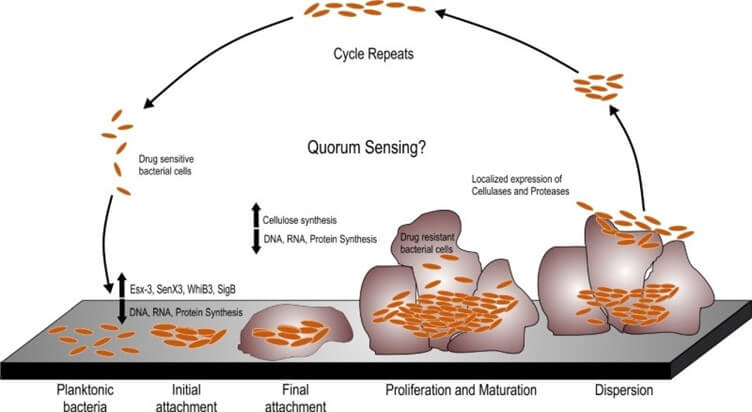Are we familiar with all the bacterial resistance mechanisms?
The significance of biofilm development in industry is obvious when taking a gander at the figures: 33% of produce in the evolved way of life is lost every year because of bacterial deterioration. Also biofilms are a steady wellspring of microbial tainting.
But do we really know what a biofilm is?
In the climate, microscopic organisms can either be found in planktonic structure, for example suspended in the climate, or in sessile structure, clung to surfaces. In particular, biofilms are totals of microorganisms that are bound to one another and clung to a surface, accordingly, one might say that they are in a sessile state.
In biofilms, microorganisms are immersed in an extracellular matrix composed of extracellular polymeric substances, proteins, and extracellular DNA. In turn, this matrix offers protection against external agents and enhance adhesion to different surfaces. The matrix performs other important functions in the following areas:
- Nutrition: It concentrates the nutrients from the environment inside the biofilm.
- Defense:It prevents or reduces the penetration and contact of antimicrobial agents with the microorganisms housed there.
- Protection:It avoids desiccation.
Its design is framed by various channels and vessels that partition the biofilm into miniature states where water, supplements, and oxygen are circulated. Substances or build-ups may likewise be ousted from the biofilm through these very channels. Transport to internal regions is more lacking, making regions with lower healthful levels and restricted oxygen, producing a climate helpful for microaerophilic or anaerobic microscopic organisms development.
These sorts of bacterial networks can be found in nature; however, they are likewise exceptionally normal on modern surfaces. Biofilms need conditions with high hydration and nourishment levels, which can be found in meat ventures or restorative producers.
These enterprises require a lot of water during creation, inclining toward the hydration of the climate and causing problem areas prompting the presence of this kind of designs. One more component to consider is the high dietary benefit of their natural substances and completed item, which would make conceivable tainting sources in case of deficient cleaning and sanitization conventions. Among these, biofilms.
Are biofilms formed by a single species of microorganism?
These communities may consist of only one type of microorganism, but it is common for those found on work surfaces or in filling systems within the industry to consist of more than one bacterial species.
Multi-life form biofilms likewise create a significant issue for the industry, as they have obstruction systems for biocides and sterilization, and can be a consistent tainting source if not dispensed with. What's more, it's anything but a simple assignment as we will see underneath.
Multispecies communities present greater structural complexity and, therefore, an improved extracellular matrix. These improvements are based on the exchange of information between bacteria, synergies and joint actions that can occur between different microorganisms. Some bonds are stronger than blood. Some species will produce enzymes that inactivate biocides, while other species will be producing metabolites that can be used by the community as a nutrient source.

Moreover, as we surely understand, microbes are microorganisms with incredible hereditary pliancy and are wanton with regards to trading this material. These extra-chromosomal hereditary exchange processes, through plasmids, are called formation. Furthermore, it has been demonstrated to be done at a higher speed in biofilms in light of the fact that they favour contact between cells. The plasmid material normally encodes opposition qualities, causing that microbes which would not be impervious to antimicrobial specialists in their regular state, produce such obstruction because of their essence in the biofilm.
Enemies or allies for industry?
Industry faces a huge struggle to ensure the disinfection of work surfaces and the control of biofilms. One of its main difficulties is to avoid the formation of these aggregations on surfaces, as well as to disable their resistance mechanisms against disinfectant agents. Its complex protection systems are mainly associated with the presence of the extracellular matrix, which makes it difficult for disinfectant agents to penetrate the innermost areas of the biofilm.
On the other hand, some authors propose another interesting approach, arguing that the strategy should not be aimed at the complete destruction of the biofilm. Rather, their reasoning is based on the presence of certain microorganisms that can generate competition for the adhesion of pathogenic microorganisms, in the same way they occur in our intestine; even a high or low count of certain microorganisms can have beneficial effects for industry, as for example in the fermentation of cold meats.
In this manner, there is still an ideal opportunity to turn the circumstance around to profit from the maximum capacity of biofilm. While always remembering or ignoring its present significance as a defilement source.
Would you like to know what the most common pathogenic microorganisms in industrial biofilms are?
|
To Find Out More |
